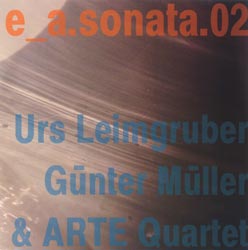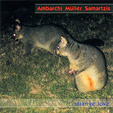Urs Leimgruber, Gunther Müller & Arte Quartet - e_a.sonata.02
Ambarchi_Müller_Samartzis - strange love (FOR 4 EARS)
 Practitioners of static music are faced with an unusual dilemma. There comes a point at which the players must decide either to do something else or to keep doing the same thing. Strictly speaking, that’s nothing new, of course, but among the wave of musicians creating improvised but barely changing music, that point is stretched and magnified to new levels.
Practitioners of static music are faced with an unusual dilemma. There comes a point at which the players must decide either to do something else or to keep doing the same thing. Strictly speaking, that’s nothing new, of course, but among the wave of musicians creating improvised but barely changing music, that point is stretched and magnified to new levels.
About nine minutes into e_sonata.02, a collaboration between saxophonist Urs Leimgruber, percussionist and manipulator Gunther Müller and the saxophone group Arte Quartet, Leimgruber pushes the envelope and makes some distinctly saxophoney sounds. He recedes quickly, and an ethereal atmosphere returns, but it has changed. The ethereal rumbles and rolls for another five minutes, at which point the horns begin to play something very nearly jazzy while Müller supplies a popping rhythm. The horns back off, and return again, countering each other with staccato lines, almost as if they were playing charts, while Müller’s backing grows fuller. They pull back again, but the setting has again changed. It might not be a detriment, but it’s still a shock. The drones and reed-biting squeals become fixed, irrevocably earthly. Eventually the horns get hard and the piece settles into a saxophone concerto for the final movement. It’s a strangely disruptive 52 minutes.
 Strange Love, Müller’s collaboration with guitarist Oren Ambarchi and soundmaker Phillip Samartzis, follows a similar dramatic arc. Müller is a quiet percussionist, generally employing small objects amplified with contact mikes and electronically altered, although recently he has also been credited with iPod. Static and drone fill the first 10 minutes, building with an odd momentum. The piece becomes increasingly active for the next 10 minutes, until it breaks with a start. Then voices appear under an unexpected flurry of motion. It ends somewhere near where it began, though with a much more mysterious edge.
Strange Love, Müller’s collaboration with guitarist Oren Ambarchi and soundmaker Phillip Samartzis, follows a similar dramatic arc. Müller is a quiet percussionist, generally employing small objects amplified with contact mikes and electronically altered, although recently he has also been credited with iPod. Static and drone fill the first 10 minutes, building with an odd momentum. The piece becomes increasingly active for the next 10 minutes, until it breaks with a start. Then voices appear under an unexpected flurry of motion. It ends somewhere near where it began, though with a much more mysterious edge.
That track, “Cooler,” is followed by the darker, denser “Warmer” (as if the track titles were switched at the printer), which is almost a sequel to the first:overlaid drones and tones and, again, children’s voices. Throughout, the three sound like one – or more to the point sound like something other than a group of musicians. Ambarchi never hits a guitar sound to speak of, and the trio melds in mood and pace. If that’s not what makes Strange Love better than the e_sonata, it is what makes it different. Whereas the sonata is saddled with the sound of saxophones, Strange
is relentlessly uninterrupted.
-
Kurt Gottschalk
Comments and Feedback:



